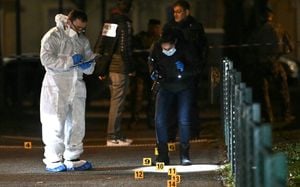The first recorded long-range air combat engagement between the Ukrainian Air Force's F-16 fighters and Russia's Su-35S took place on February 21, 2025, marking a significant escalation in the conflict. According to the Military Observer Telegram, this engagement highlights dynamic and risky maneuvers by both sides, underscoring the changing nature of aerial combat as Ukraine continues to fortify its defenses.
Reports indicate missiles engaged during the combat were likely launched from Western Ukraine or nearby NATO member countries, showing the possibility of cross-border military involvement. While the exact damages or casualties resulting from this engagement have not been disclosed, the mere existence of such air clashes speaks to the intensifying military operations marking this conflict.
Currently, the Ukrainian Air Force operates approximately 20 F-16 fighters, which have begun to engage more frequently near Russia's borders, particularly around Kursk, as indicated by additional reports from Archangel Spetsnaz on February 22. This increased operational range signifies Ukraine's tactical shift and readiness for direct confrontation with Russian forces.
With F-16s now conducting missions closer to Russian territory, they are reminiscent of prior engagements where Ukrainian forces deployed MiG-29 fighters more aggressively. Significantly, one such MiG-29 was reported to have dropped precision-guided munitions targeting Sverdlikovo in Russia on February 20. This bolstered military presence has been paired with the strategic transfer of troops and resources to the Sumy region, aimed at reinforcing operational capacity against potential incursions.
Beyond aerial engagements, the broader military dynamics between the two nations are evidenced by the continual upgrading and diversifying of tactical assets. The recent introduction and effectiveness of artillery platforms like HIMARS have also played pivotal roles, with reports describing successful strikes on Russian anti-air systems. Such developments raise the stakes for engagements moving forward as both sides adapt to the shifting battlefield realities.
This new phase of aerial confrontations also raises intriguing questions about command and control strategies employed by both the Ukrainian and Russian militaries. The choice of engaging at such proximity to contested borders indicates calculated risks and responses to perceived threats as each nation seeks to assert its dominance over the skies.
Overall, the intricacies of these air battles exemplify the larger theater of warfare underway, where air superiority is becoming increasingly contested. While the immediate outcomes of these engagements may not reflect severe losses, the strategic posturing and operational tempo signal the potential for future escalations. The stakes remain increasingly high as both Ukraine and Russia navigate this complex web of aerial combat, each grounding their movements on domestic and international pressures.
Understanding the evolution of these tactics and the ramifications they entail is fundamental for comprehending the conflict's broader significance. The consistent appearance of Ukrainian air forces near Russian borders provides insight not only on military engagement methodologies but also on territorial assertions and political signals exchanged between the two nations. This chapter of aerial combat engagements forms just one piece of the continuing conflict puzzle, reshaping expectations and future encounters.



